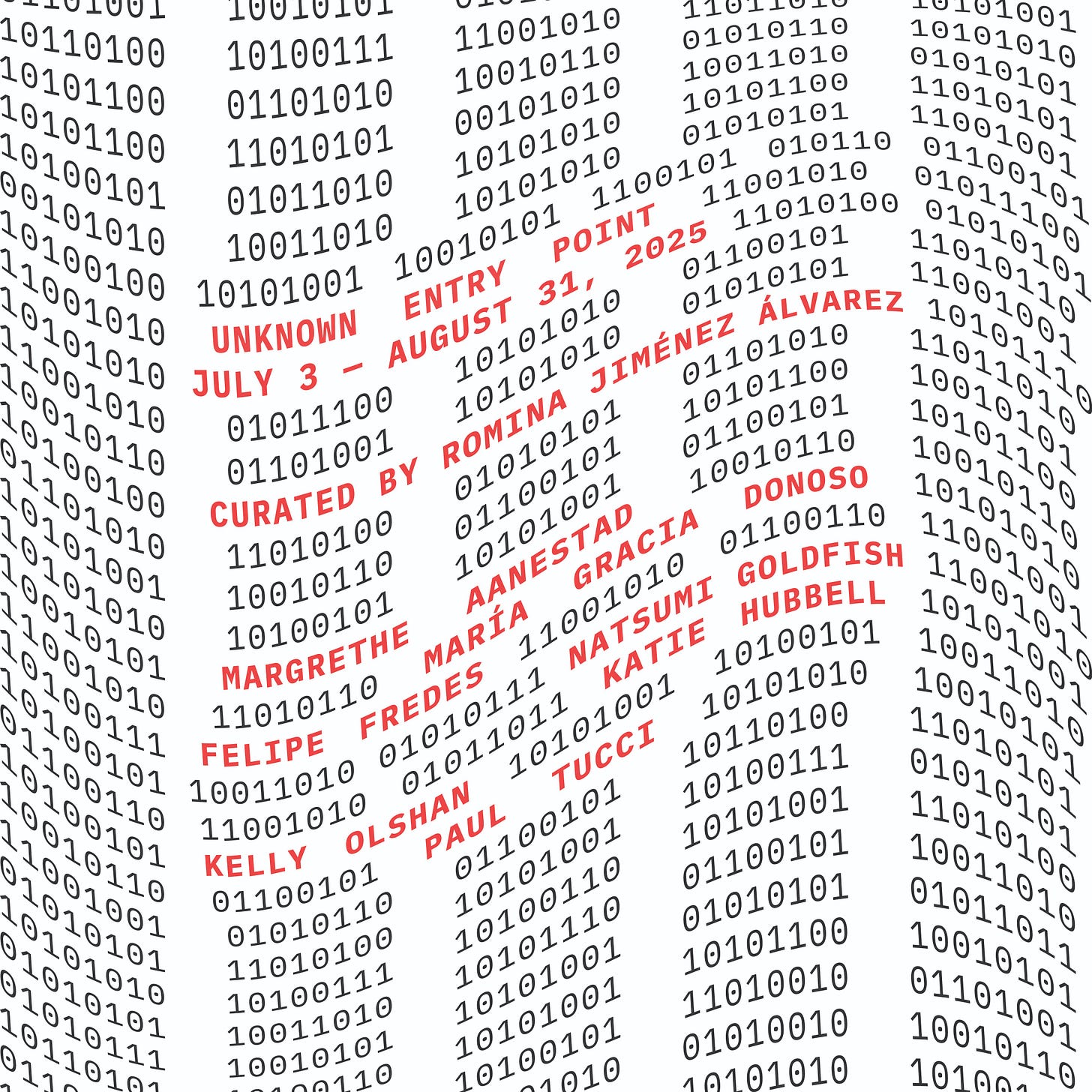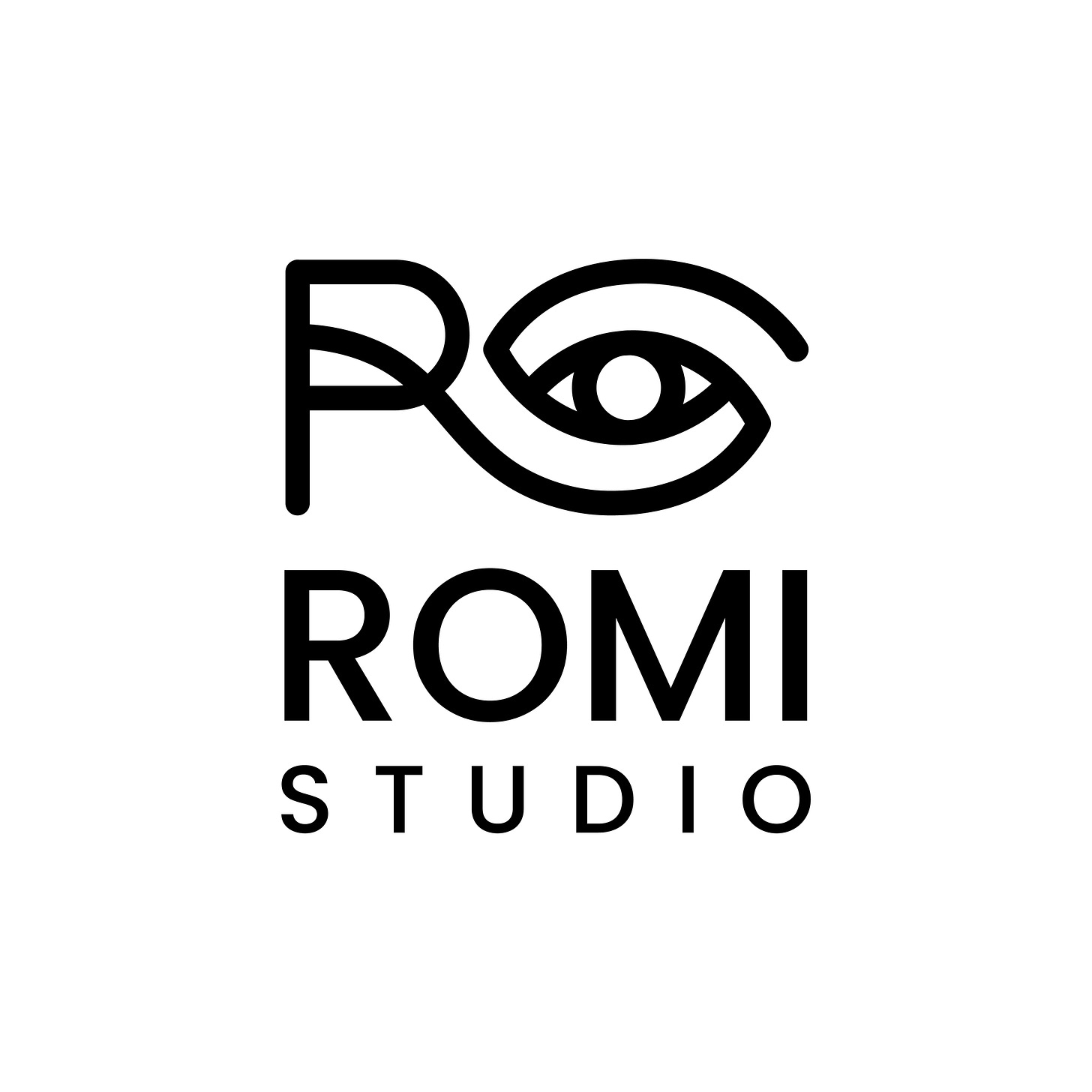Portrait 24: Unknown Entry Point Opens Tomorrow – Artist Performance at 8 PM
Tomorrow we return. Celebrate with us at the Bellslip for the opening reception and the gallery’s first-ever artist performance.
Romi Studio is proud to present Unknown Entry Point, a group exhibition on view July 3–August 31, 2025, at the Bellslip Gallery in Greenpoint, Brooklyn. We warmly invite you to join us for the opening reception this Thursday, July 3, from 6–9 PM, featuring the gallery’s first-ever artist performance at 8 PM—a sound-based healing performance by exhibiting artist María Gracia Donoso.
With Unknown Entry Point, Romi Studio ushers in a new chapter for the Bellslip Gallery—presenting an exhibition anchored in collaboration, curatorial integrity, and expanding the gallery’s program to include sculpture, performance, new media, and site-specific installation.
The exhibition presents seven artists—Margrethe Aanestad, María Gracia Donoso, Felipe Fredes, Natsumi Goldfish, Katie Hubbell, Kelly Olshan, and Paul Tucci—six of whom live and work in Greenpoint. Felipe Fredes, the lone outlier, is based in Denmark—after all, there had to be an unknown entry point somewhere. Together, the artists explore porous boundaries between the physical, digital, and conceptual, offering works that invite new ways of seeing and sensing.
This is the gift of your species and this is the danger, because you do not choose to control your imaginings. You imagine wonderful things and you imagine terrible things, and you take no responsibility for the choice. You say you have inside you both the power of good and the power of evil, the angel and the devil, but in truth you have just one thing inside you — the ability to imagine.
— Michael Crichton, Sphere (1987)
Read Full Press Release Below:
(Brooklyn, New York & Artsy.net) — An unknown entry event is unfolding in Greenpoint. Romi Studio returns—after a long, quiet orbit—with Unknown Entry Point, a group exhibition presenting seven artists navigating unstable thresholds between the physical, digital, and conceptual. Curated by Romina Jiménez Álvarez, the exhibition brings together Margrethe Aanestad, María Gracia Donoso, Felipe Fredes, Natsumi Goldfish, Katie Hubbell, Kelly Olshan, and Paul Tucci, each of whom challenges the porous categories that define painting, sculpture, and experience in contemporary art. The exhibition will open with a reception on July 3, featuring the gallery’s first-ever artist performance—a sound-based healing activation by María Gracia Donoso at 8 PM. Presented in partnership with Brookfield Properties, the show runs from July 3 to August 31 at the Bellslip Gallery and online via Artsy.net.
Installed within a residential building, the exhibition mirrors our contemporary condition—eyes flickering between screens and surroundings, bodies navigating increasingly “phygital” terrains. Drawing on Shumon Basar’s concept of the 2.5th Dimension—between visual interface and embodied experience—the exhibition operates on two levels: first, in the perceptual state of the viewer, oscillating between their phone and the physical world around them; and second, in the artworks themselves, which blur across media, extend off the wall, and resist legibility. Meaning arises not through recognition, but through friction, tension, and spatial interference.
The title Unknown Entry Point is inspired by the 1998 sci-fi film Sphere, in which an alien intelligence discovered at the bottom of the ocean becomes a mirror for human subconscious fears and desires. The alien offers no explanation—its presence alone is enough to destabilize and transform. In this exhibition, the Bellslip’s silver-finned walls become the rolling sands of the ocean floor, a site of alien contact and unknowable depth. Like the gold Sphere in the film, the artworks here do not explain themselves. Each work reflects the internal workings of the artist, and the viewer completes the encounter through thought. As Hermann Hesse once warned, “Ah! In fifty years the earth will be a graveyard of machines, and the soul of the spaceman will simply be the cabin of his own rocket!” The artworks themselves are analog and digital machines—sensory instruments and transmitters—reverberating across space and time.
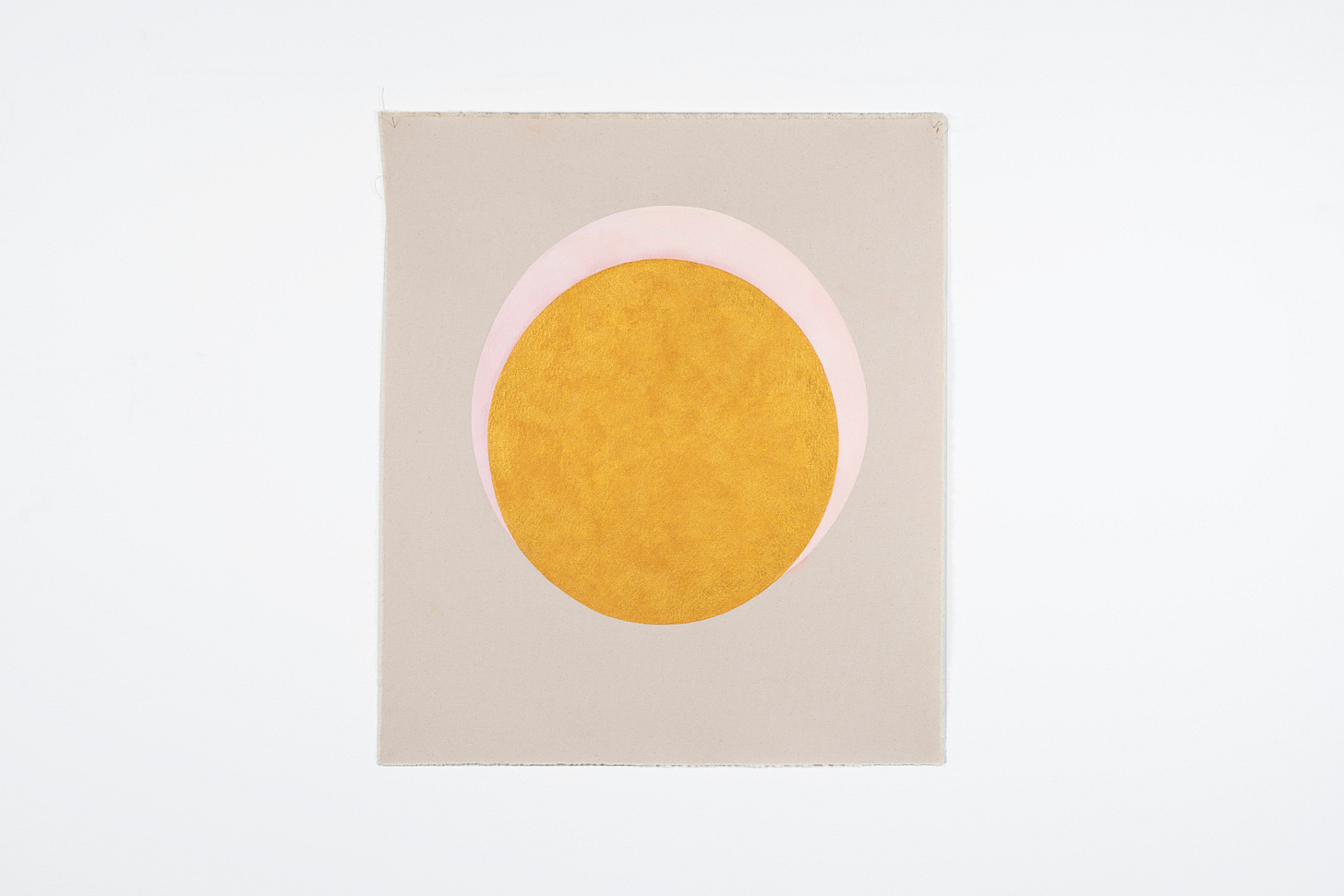
Margrethe Aanestad’s gold painting sets the stage—literally and metaphorically. Positioned as the first work a viewer encounters in the gallery, her golden circle echoes the alien orb from Sphere (1987)—mysterious, silent, reflective. Like the Sphere, it does not explain itself. Rendered with precision and subtle depth, the circle becomes a portal—an opening rather than an image. From this entry point, the exhibition unfolds through perceptual thresholds.
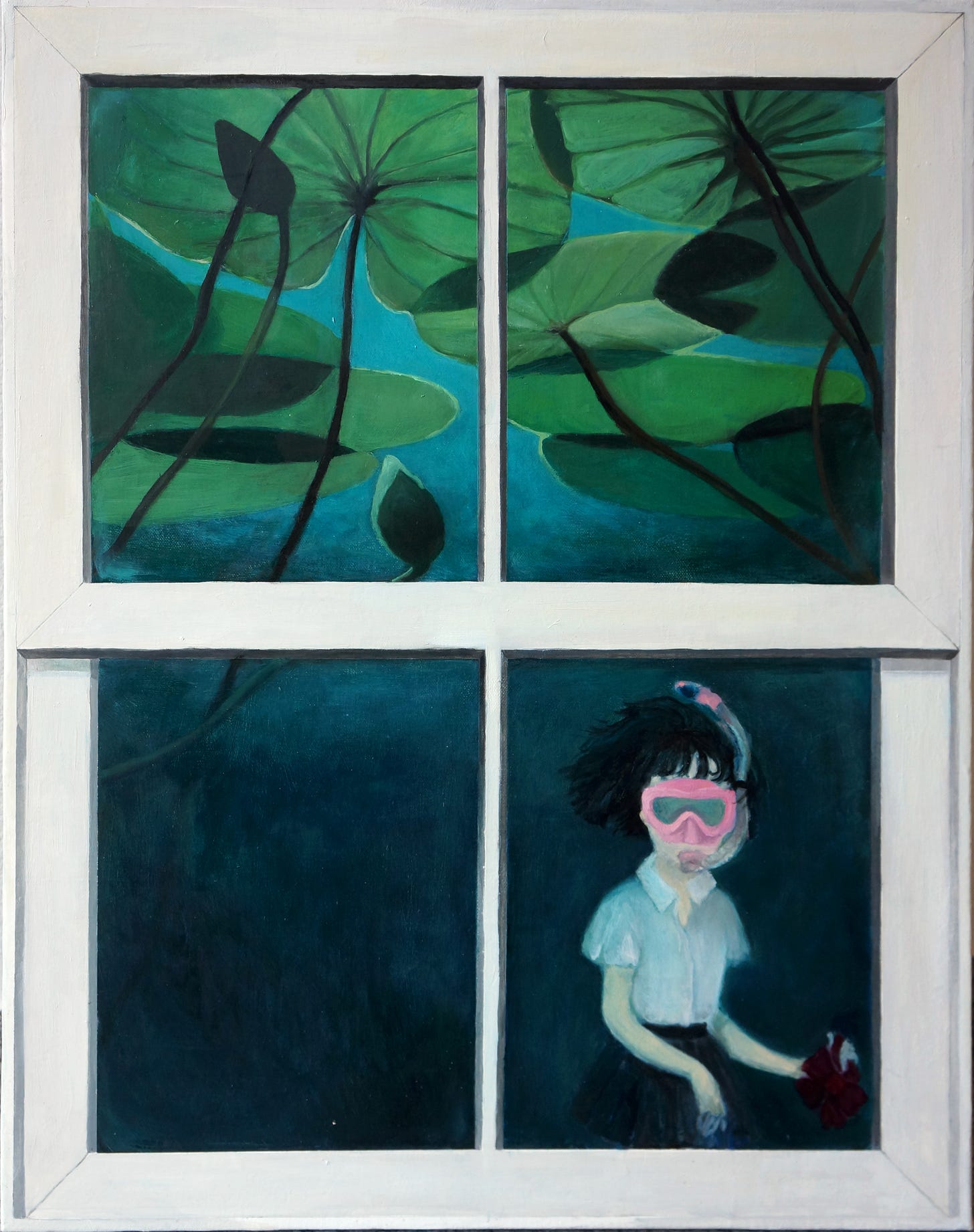
In A Schoolgirl’s Liberation (2018), Natsumi Goldfish presents a figure submerged beneath a canopy of lilies—pink snorkel, school uniform, red school bow tie in hand. Like the characters in Sphere, she peers back from an uncanny body of water. Who is truly submerged—her, or us? The deepest part of the ocean is as unknowable as the cosmos, and this painting primes the viewer to those same liminal, affective depths. “My work reflects my everyday life,” Goldfish writes, “not like a mirror does, but like the surface of a rippling pond.”
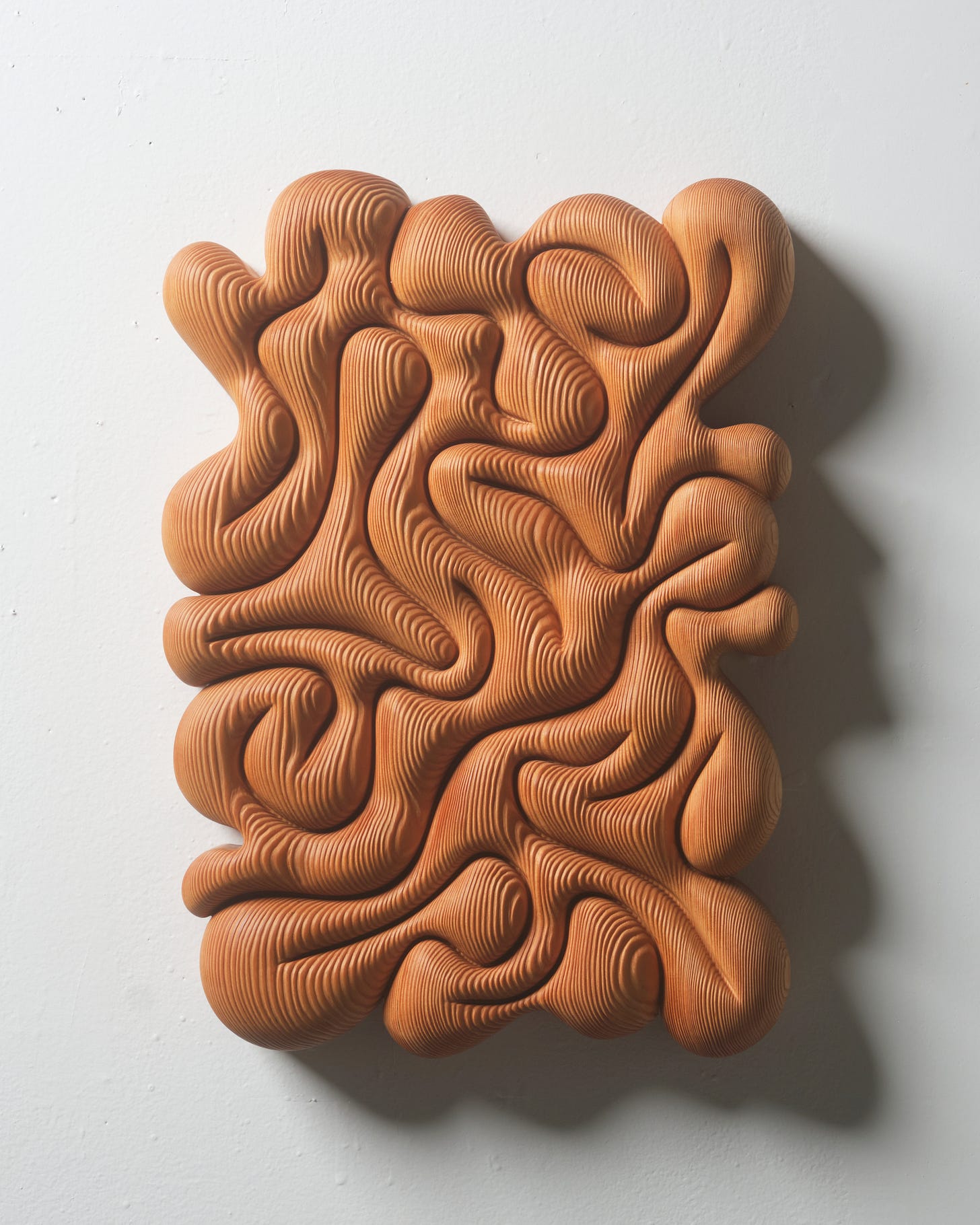
Paul Tucci’s hand-carved wall sculptures begin with blocks of wood found on the street. Sometimes he starts with a drawing, but form is ultimately discovered through the act of carving itself. Trained as a carpenter and working with both traditional and modern techniques, Tucci approaches the material with a practiced attunement—subtracting, sanding, refining—until the object reveals what it wants to become. The resulting biomorphic forms curve and swell: sometimes like the canopy of trees, other times like the rounded contours of bubble graffiti, recalling the city surfaces they came from. It’s as if Tucci’s source imagery—trees, graffiti, the textures of the street—has been reincarnated into these organic forms, enveloped in wood, and ushered into three curved dimensions—and perhaps a fourth. The wood carries time. It carries memory.
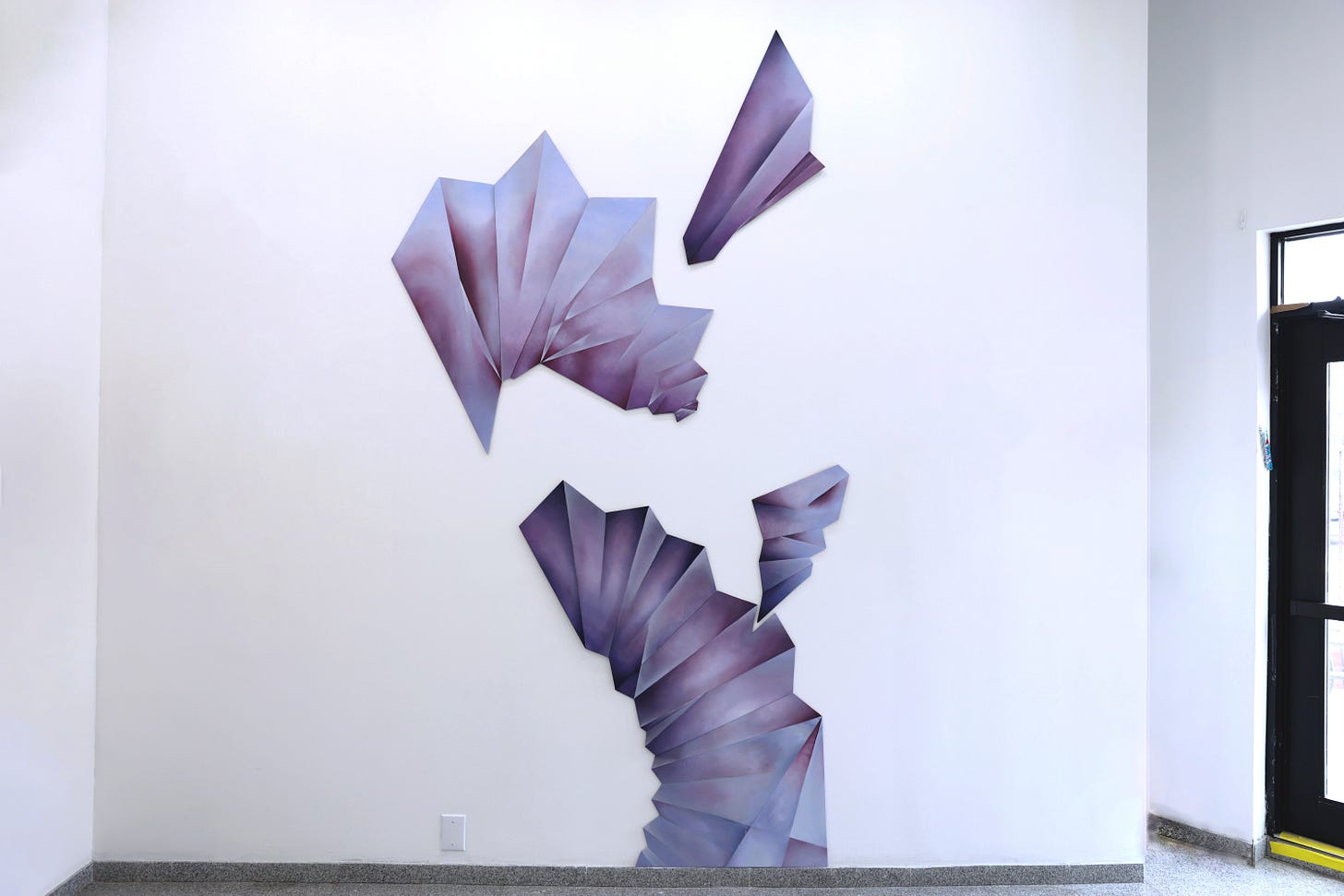
Recalling Sphere, where the alien’s power is to crystallize human fears and desires, Kelly Olshan’s Amethyst Staircase (Interactive Installation) (2025) builds the staircase to meet our own. “My work responds to the idealism and anxiety of endless striving,” she writes, “grappling with a relentless fixation on a better elsewhere.” Her staircases are splintered— like the amethyst rocks they are named after. They evoke architectures not of arrival, but of aspiration: fractured paths pointing toward imagined futures. And if the future is always built from what’s come before, Olshan offers the tools— irregular shapes and fragments—through a site-specific installation designed to construct your own rocky stairway.
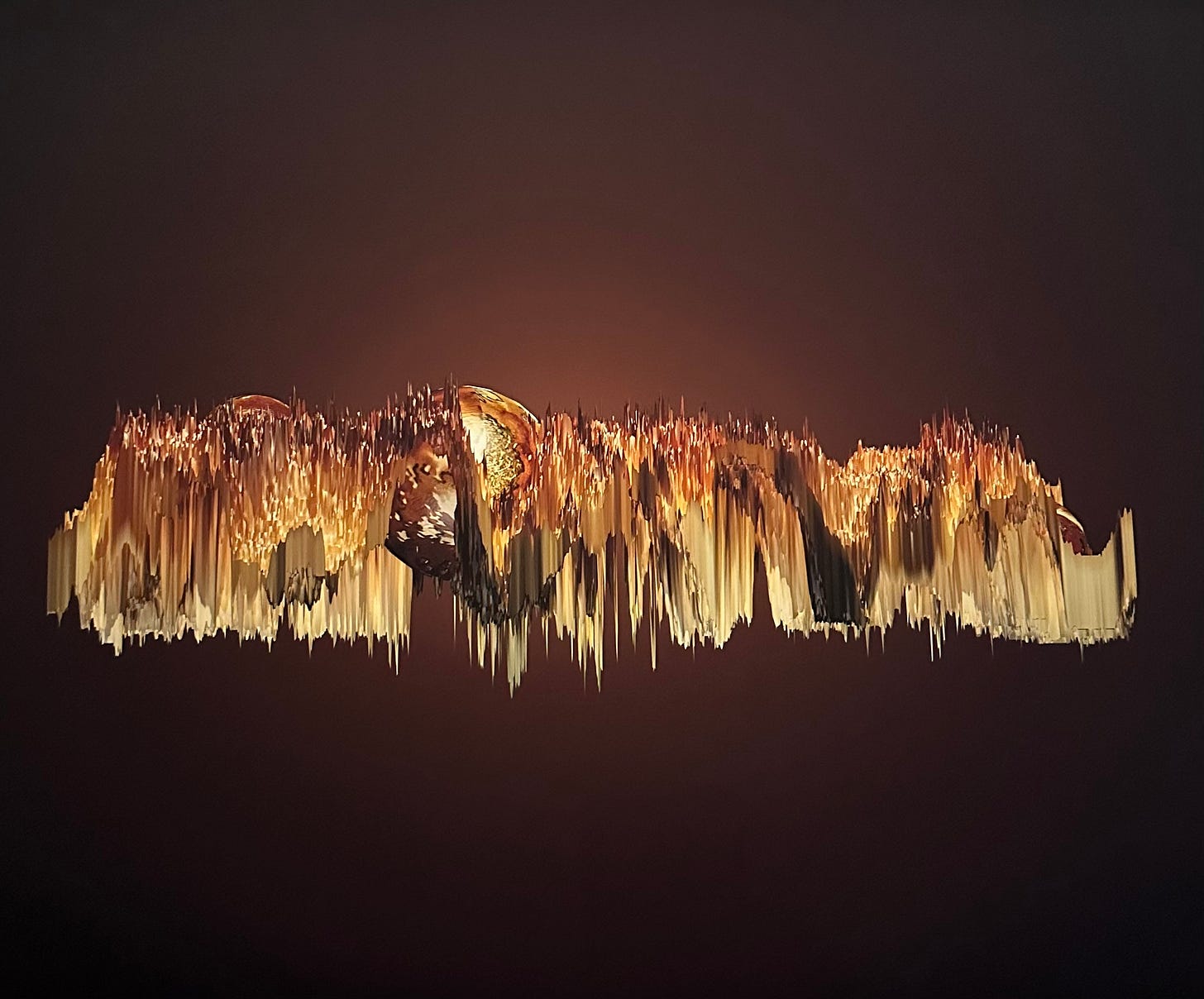
Stepping into imagined elsewheres and futures, we arrive at María Gracia Donoso’s work. Embedded within the black structural islands of the gallery, her pieces feel like discoveries in planetary craters. Donosco approaches form as a kind of speculative archaeology. Her Suspension Ontologies ask: what emerges when perception is detached from habit, when vision follows unfamiliar logic? Donosco begins with fluid, organic drawings—ink and pigment moved by gravity, salt, and time—then processes them digitally, allowing software to transform and mutate rather than translate. The results are crystalline structures, uninhabitable cities, and fragmented topographies that hover between the earthly and the alien. “There are no stable coordinates,” she writes, “what we call space may be an illusion of continuity.”
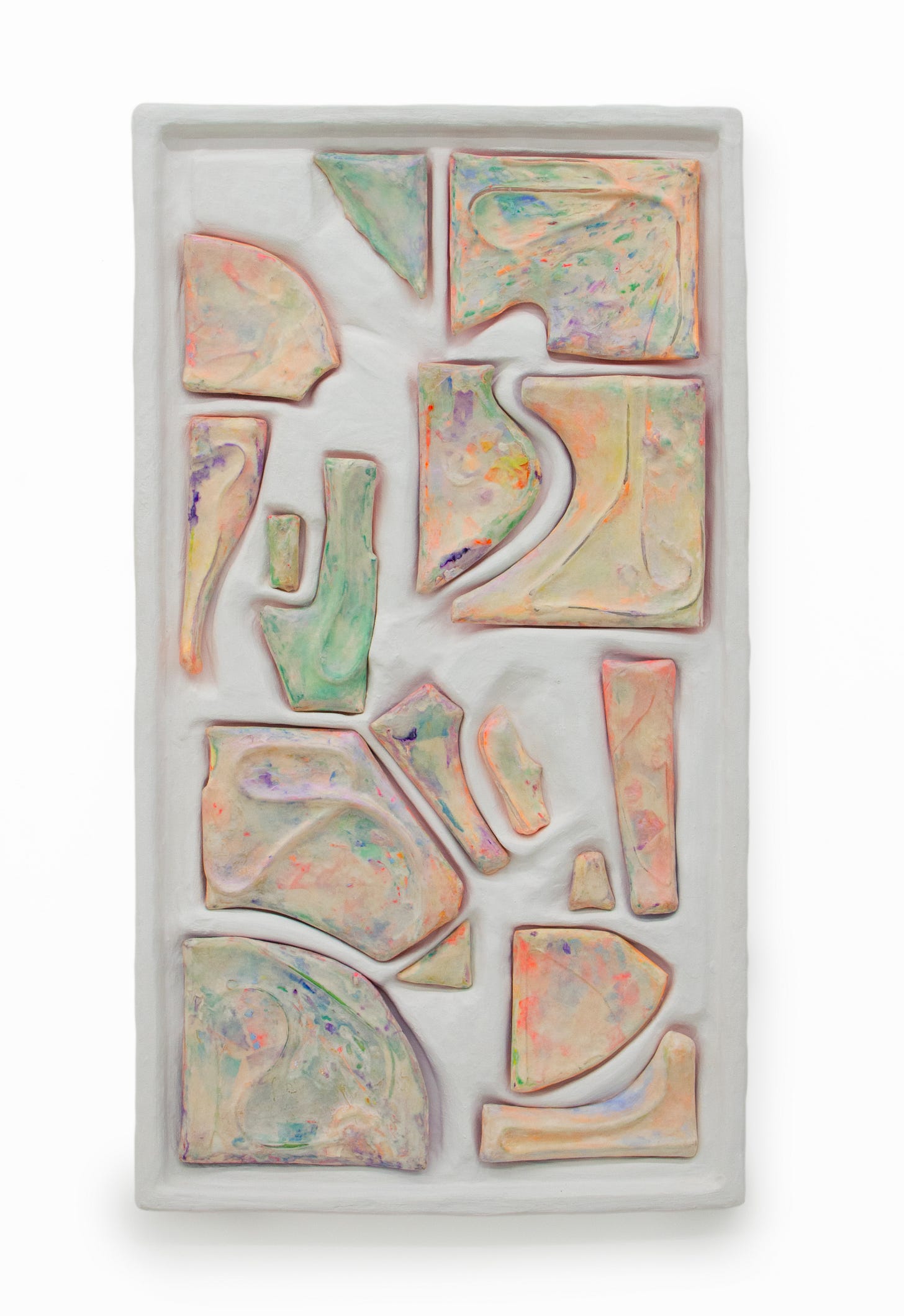
Katie Hubbell’s paintings feel like samples pulled from under a microscope—soft, sealed, and alive. Built from a mix of materials like milky paper pulp, mica dust, cold porcelain, and fabric, her pieces form surfaces that oscillate between object and organism. In the Epiphragm series (2022), a snail—formed from cold porcelain—sits gently atop a pastel panel, referencing the delicate membrane snails create to survive drought. It’s an act of sealing in, of staying with. Perhaps humans could learn from that: how to pause, protect, and dwell in dry conditions. To stay with the unknown— let us say, a present-endured.
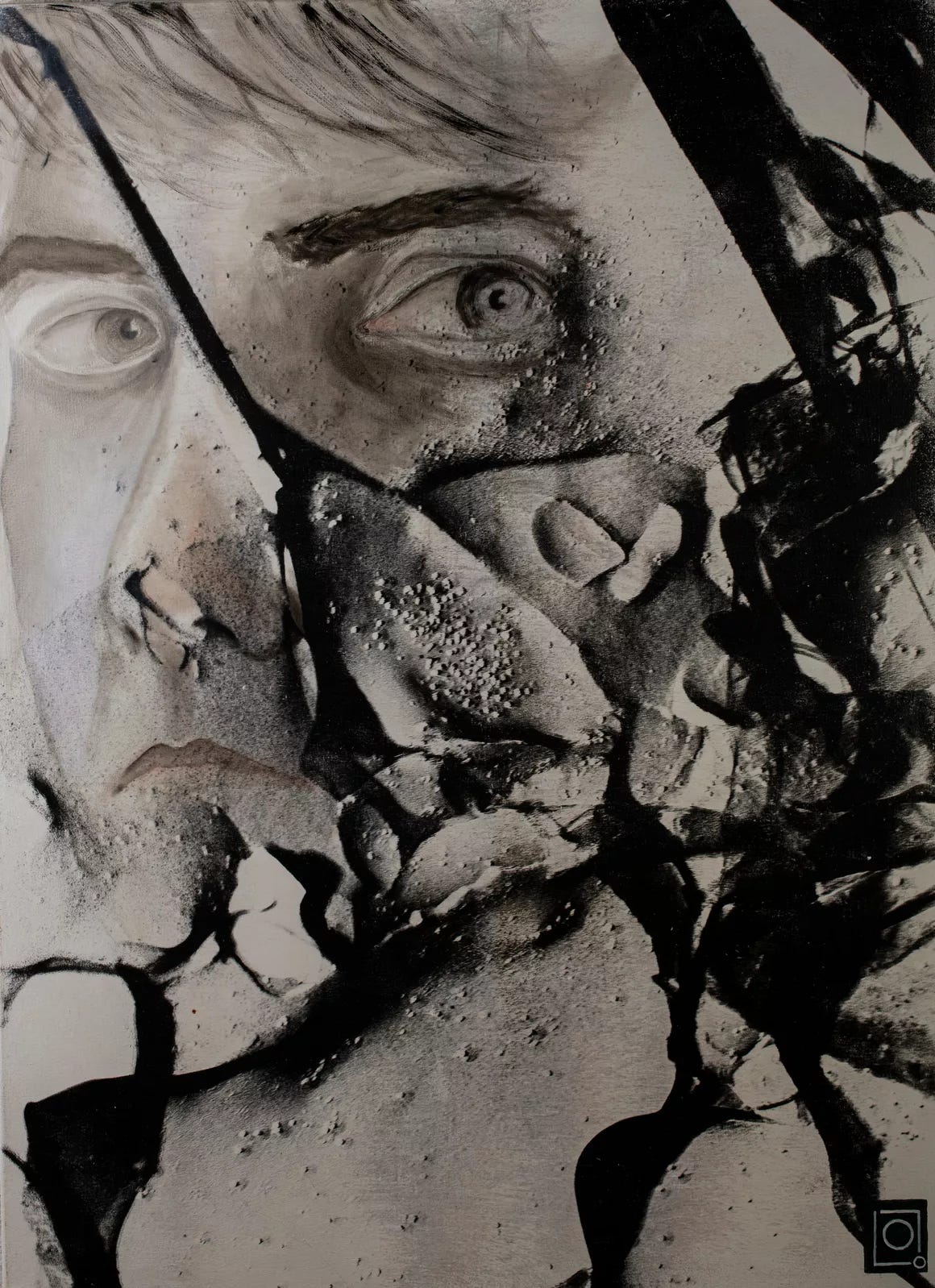
Felipe Fredes continues the dialogue between art and science through a body of work that begins at the microscopic level. Fredes is an interdisciplinary artist and professional neuroscientist with a Ph.D. in Neurobiology and Cellular and Molecular Biology from the Universidad de Chile. His prints originate from brain tissue images captured using freeze fracture labeling and Transmission Electron Microscopy (TEM)—a technique that reveals structures more than 500,000 times smaller than the human eye can perceive. These subcellular craters—abstract, planetary, almost lunar—become the backdrop of his own Self Portrait (2017): an image of himself layered over an image of a brain. Neither map nor mirror, they question where the self begins—and whether it can be located at all.
It’s worth noting that Fredes is the only artist in the exhibition not currently based in Greenpoint—he lives in Denmark and works from a shipping container-turned-studio, crane-lifted atop his bike shop where he makes bespoke bikes. A fitting anomaly. After all, there had to be, somewhere, an unknown entry point.
Unknown Entry Point does not offer closure; instead, it lives in contradiction. The exhibition could be unfolding in 1825 or 3025. Romi Studio, ever-nomadic and ever-collaborative, emerges again not with answers, but with a deepened commitment to the question. As John Cage once reflected on Schoenberg: “The answers have the question in common. Therefore the question underlies the answers.” This exhibition, too, is held together by its questions. The goal is not clarity—it’s duration. To keep you there, inside that question mark, a little longer.
The All-World trembles; the All-World trembles physically, geologically, mentally, spiritually, because the All-World is looking for the point—not the station, but the utopian point where all the world’s cultures, all the world’s imaginations can meet and hear one another without dispersing or losing themselves. And that, I think, is utopia, above all. Utopia is a reality where one can meet with the other without losing himself. — Édouard Glissant
Exhibition presented in partnership with Brookfield Properties. Free and open to the public. For any inquiries, please contact: romina@romi-studio.com.


